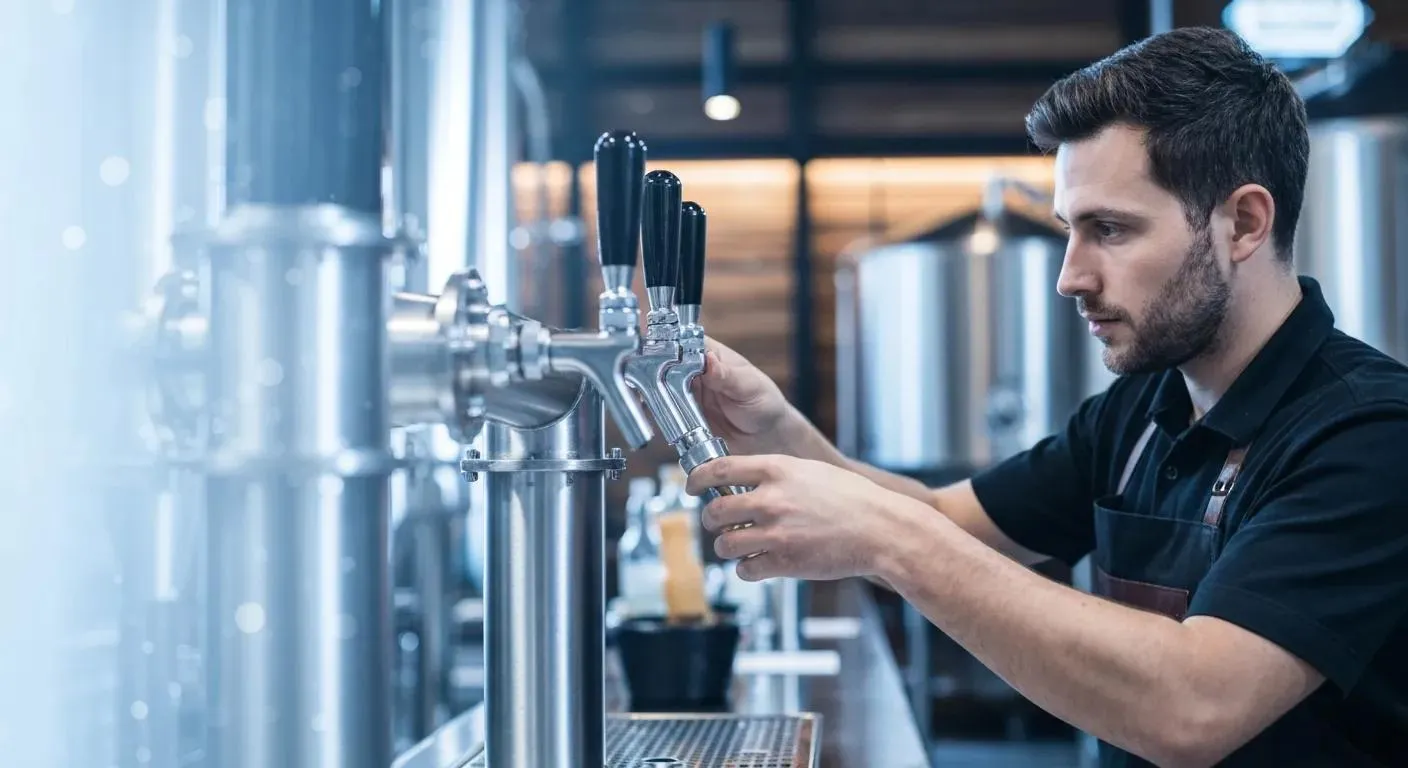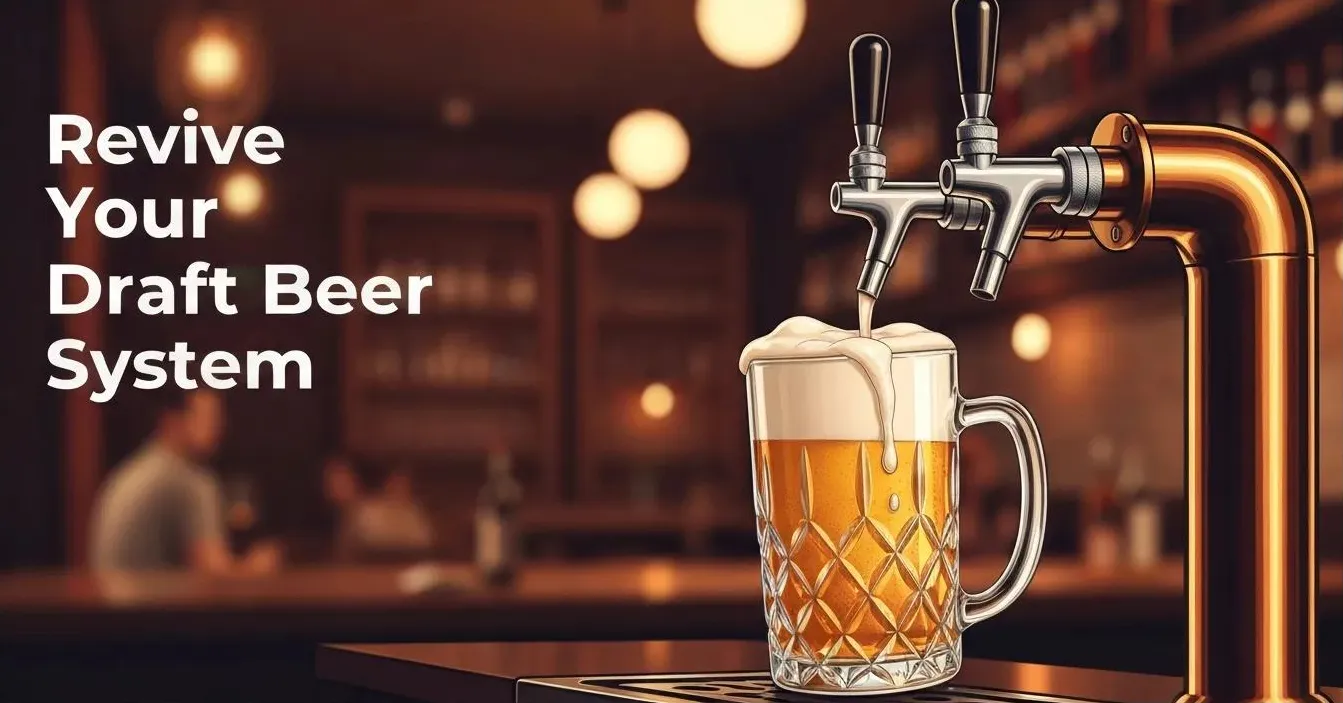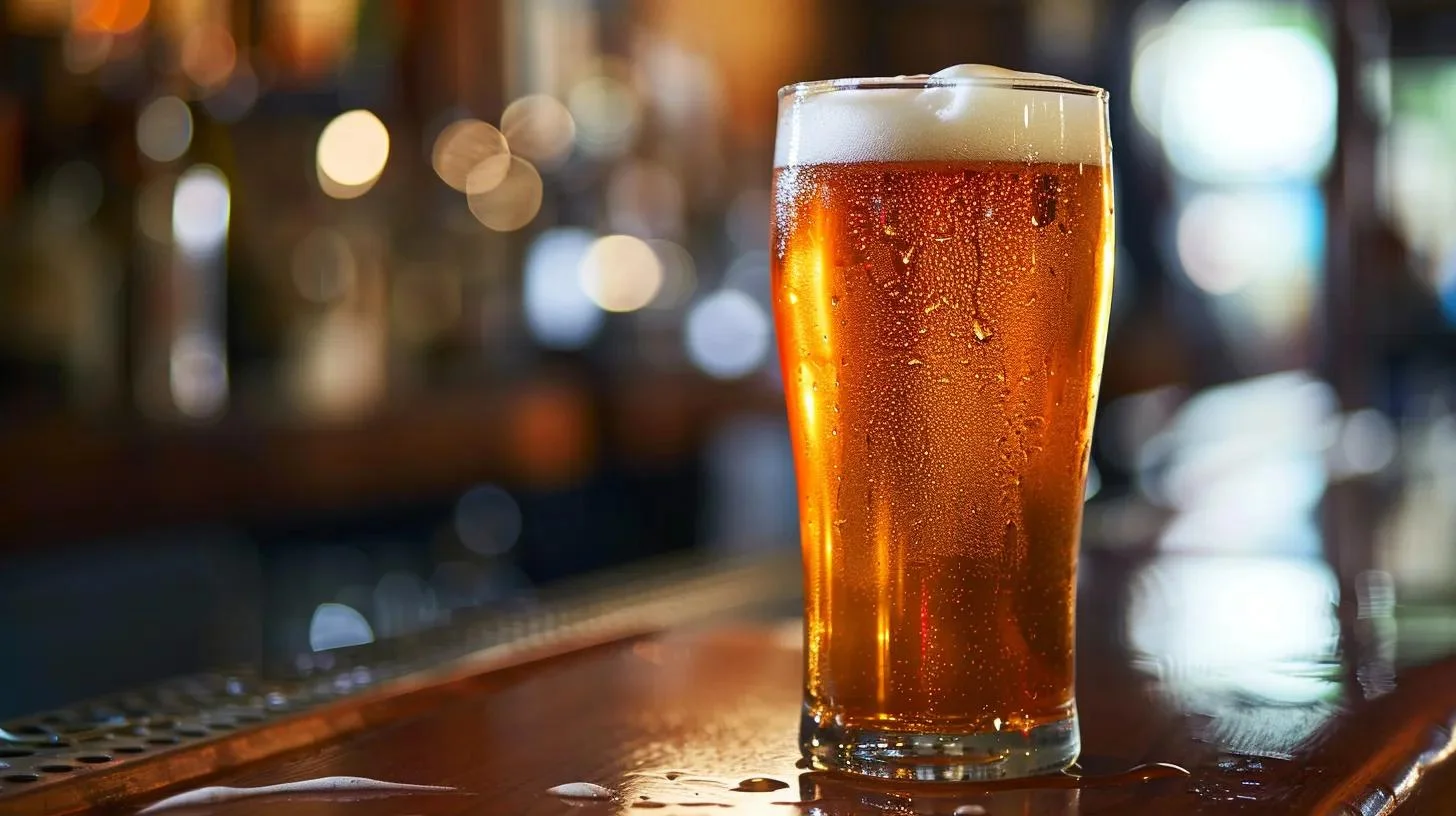How You Can Tell if You're Drinking from a Dirty Beer Line: Signs of Contamination

Enjoying a refreshing pint of draft beer is one of life’s simple pleasures. However, the quality of the beer can be significantly compromised if it’s dispensed through dirty beer lines. The freshness, flavor, and aroma of your beer hinge on the cleanliness of the lines from which it’s poured. Signs of contamination from dirty draft lines can manifest in various ways; it might be a strange taste, an off-putting smell, or even the beer’s cloudy appearance. Ignoring these signs not only impacts the drinking experience but could also pose health concerns.
Regular maintenance and cleaning of beer lines are critical for breweries and bars to ensure their customers receive the highest quality pour. Dirty beer lines can significantly alter beer tastes, leading to sour or unusual flavors that detract from the intended experience. This commitment to cleanliness also speaks to the establishment’s regard for beer quality and customer satisfaction. Understanding the importance of these practices can enlighten consumers about what to expect and seek out when enjoying their favorite draught beer. By being informed, both consumers and providers can uphold the standards that honor the brewer’s craft and the beer drinkers’ enjoyment.
- Dirty beer lines affect the taste, smell, and appearance of draught beer.
- Beer line cleanliness is essential for optimal beer quality and patron satisfaction.
- Maintenance routines are crucial to prevent contamination and preserve beer integrity.
Recognizing the Signs of Dirty Draft Lines
Dirty draft beer lines can significantly impact the quality of the beer. This section breaks down the tell-tale signs of dirty lines, across taste, visual aspects, and physical responses.

Taste and Aroma Indicators
The first indicators of contamination in draft beer lines are often taste and aroma. The presence of microorganisms or residues can make beer flavor impart off-flavors that range from metallic to sour. Stale or funky flavors are a strong indication that the beer might be tainted from a dirty beer line. Furthermore, if the beer emits unusual or unpleasant aromas, the beer line likely requires cleaning.

Visual Clues
Visual assessment can reveal several clues indicative of a dirty beer line. A healthy pour should maintain foam, also known as head retention, which could be compromised if the lines are not clean. Additionally, look for legs forming on the inside of the glass which should linger; a rapid loss means there could be residue affecting the beer’s carbonation and quality. Cloudiness or particulate matter can also indicate an underlying infection in the lines, as various bacteria and yeast can infect beer lines, leading to spoiled flavors and potential health issues.
Physical Symptoms
Drinking beer from a contaminated line may lead to physical discomfort. Although less immediate than taste and visual clues, the physical symptoms such as gastrointestinal upset could point to the presence of unwanted microorganisms. It is important to consider these symptoms, especially if they correlate with beer consumed from establishments where the cleanliness of the beer line is uncertain.
Causes of Beer Line Contamination
Ensuring beer quality depends significantly on maintaining a clean delivery system. Contamination in beer lines can stem from several sources, affecting the beer’s taste, appearance, and safety. Dirty draft lines ruin the flavor and integrity of all the beer, making it crucial for establishments to implement effective cleaning practices.

Organisms and Residues
Microorganisms: The presence encouraging growth of bacteria, mold, and yeast is one of the primary causes of beer line contamination. These organisms can multiply within the beer lines, especially when optimal conditions for growth, such as moisture and moderate temperatures, are present.
Biofilms: These are complex communities of microorganisms that adhere to surfaces in wet environments. In beer lines, biofilms can protect bacteria and other contaminants, making them particularly resistant to regular cleaning.
Residues: Regular beer flow from tap system can leave behind sugars and proteins from the beer itself, which can accumulate over time. Inadequate maintenance and cleanliness of beer taps can exacerbate this build-up, providing an ideal environment for microbial growth.
Maintenance Issues: The lack of regular and thorough draft line maintenance can lead to the accumulation of all the above contaminants. It is crucial that proper cleaning protocols are followed to ensure the residue and microorganism build-up is properly managed and eliminated. Ensuring a clean draft line is essential for maintaining beer quality and customer satisfaction.
The Cleaning Process
Keeping draft lines clean is critical for maintaining the quality and taste of beer. The cleaning and brewing process removes potential contaminants that could affect the beer’s flavor and also prevents the buildup of yeast, bacteria, and beer stone. Clean beer lines are essential for both safety and customer satisfaction.
Routine Maintenance Procedures
Routine maintenance is a vital component in the upkeep of beer lines. Establishments should follow a based on industry standards, typically cleaning their beer lines every two weeks. It is the benchmark for optimal cleanliness and quality control.

Beer Line Cleaning Solution and Equipment
A comprehensive beer line cleaning solution requires specific cleaning solutions and equipment. Beer lines should be cleaned using a cleaning solution to ensure all organic material and microorganisms are eradicated. Equipment such as a recirculating pump, which allows for effective circulation of the cleaning solution, and safety glasses for protection are essential components of the cleaning apparatus.

Step-by-Step Cleaning With Recirculating Pumps
Recirculating pumps streamline the beer line cleaning process, ensuring a thorough and efficient cleaning. Here is a brief overview:

To clean a remote draft system using recirculating pumps, follow these simplified steps.
1. Get Ready: Make sure you have all your cleaning tools and solutions. Think of it like gathering your cleaning kit before tackling a messy room.
2. Safety First: Always remember to handle cleaning chemicals carefully. It's like dealing with strong cleaning agents – you need to be cautious. Wear safety glasses and gloves.
3. Disconnect Kegs: Before disconnecting the kegs, ensure that the gas is shut off to prevent any potential leaks or safety hazards. Once the gas is off, disconnect the keg couplers from the kegs in the beer walk-in and connect the couplers with couplings to form part of the circuit.

4. Disconnect Faucets: Disconnect Faucets and connect jumper lines. Put Faucets into cleaning solutions and let them soak for at least 20 minutes.
5. Prepare Cleaning Solution: Mix the cleaning solution as instructed. Follow the instructions.
6. Connect to Pump: Hook up the system to the recirculating pump. Imagine connecting beer tubing from a water pump to a garden hose.
7. Start the Cleaning Cycle: Turn on the pump and let the cleaning solution circulate through the system. Circulate for at least 15 minutes.
8. Soak Time: Let the solution sit in the lines for a bit, like letting a soapy sponge sit on a dirty dish.
9. Flush with Water: After the soak, flush the system with clean water. Think of it as rinsing soap off your dishes. Verify that all the chemicals are out of the beer system using PHP Paper. You want the system to mirror the establishment's tap water. Typically it's 7.

10. Reconnect Kegs: Once everything is clean and rinsed, hook the kegs back up.
11. Test the System: Finally, run some beer through the system to make sure everything works.
Remember, cleaning a draft system is important to keep the beer tasting good, just like how cleaning your room is important to keep it nice and tidy!
Safety and Best Practices
Maintaining safety while cleaning beer lines is paramount. Best practices dictate the use of safety glasses and gloves to protect against chemical burns and splashes. Always ensure equipment, including parts and components, is handled correctly to avoid damage and to guarantee consistent quality control. After rinsing, clean draft lines should be checked to confirm that no cleaner residue remains, as this can harm the taste and safety of the beer.
Impacts of Beer Line Maintenance on Beer Quality
Routine maintenance of beer lines is essential to preserve the inherent quality and sensory attributes of draft beer. Proper upkeep ensures that the texture, consistency, and carbonation of beer served remain true to the brewer’s intent, making it safe and enjoyable to drink beer.
Importance for Retailers and Consumers
Retailers are the gatekeepers of the draft beer system, responsible for providing top-notch service to beer lovers. They must acknowledge that the condition of dirty draft beer lines directly affects every pour, impacting the success of their service in the industry. Regular maintenance activities prevent the accumulation of yeast, bacteria, and beer stone, elements that can lead to an off-taste in beer (Beer Line Maintenance: How Clean Beer Lines Impact Quality, Taste). When beer draft lines are not cleaned adequately, the carbonation can dissipate quickly, resulting in a flat beverage that falls short of the expected quality.
For consumers, the assurance that they are drinking from clean beer lines translates into a superior drink experience. The texture and consistency of the beer are properly maintained, which is integral for enjoying the subtle intricacies of flavor and aroma (How You Can Tell if You're Drinking from a Dirty Beer Line). Through unfaltering maintenance standards, retailers can deliver a product that satisfies consumers' expectations of quality and enjoyment.
Brewery Best Practices and Standards
To ensure the delivery of high-quality beer to consumers, breweries adhere to industry standards and best practices, focusing on cleanliness and regular maintenance of beer lines. These practices are pivotal in preventing beer stone buildup, oxidation, and contamination, which can lead to off-flavors like diacetyl in beer.

Recommendations from the Brewers Association
Brewers Association recommends that breweries implement comprehensive Standard Operating Procedures (SOPs) for maintaining clean beer lines. These guidelines emphasize:
- Cleaning Frequency: Beer lines should be cleaned at a minimum every two weeks to prevent buildup of yeast, bacteria, and beer stone, which can negatively affect beer taste and appearance.
- Cleaners: It's crucial to use the correct cleaning agents. Alkaline-based cleaners are generally recommended for removing organic deposits, while acid cleaners help dissolve inorganic minerals like beer stone.
- Temperature Control: Consistent temperatures are fundamental in fermentation and storage, as fluctuations can harm beer quality. Beer should be stored in a refrigerator below 40° F (4° C) to maintain quality and prolong shelf life.
Creating a Maintenance Schedule
A well-defined maintenance routine cleaning schedule can make the difference between pristine beer lines and ones that degrade beer quality through microbial growth and the introduction of off-flavors. Breweries should exercise:
- Consistency: Regular cleaning intervals, documented and adhered to by brewery staff, help maintain a high standard for clean beer lines.
- Documentation: Detailed records of cleaning frequency, solutions used, and the staff responsible for maintenance tasks contribute to effective management and accountability.
By adhering to these practices and standards, brewers help ensure that the beer served is as fresh and high-quality as when it left the fermentation vessel.
Drinking beer from a clean line is fundamental for a bar owner the perfect beverage experience. Key indicators that can signal a consumer or bar is drinking from a dirty beer line include:
- Loss of Head Retention: A beer poured from a clean line should maintain a frothy head for a considerable time. A rapid disappearance suggests potential contamination.
- Lack of Beer "Legs": Clean lines will allow beer to cling to the side of the glass, creating "legs." Absence of these indicates potential issues.
- Flat Taste: Beer should be bubbly and effervescent. If it seems quickly flat, the beer line may not be clean, leading to loss of carbonation.
Contaminants in beer lines, such as bacteria and yeast, can impart off-flavors to the beer, making it taste stale or sour. Recognizable off-flavors can include a buttery taste or a smell reminiscent of sweat socks, suggesting the presence of certain bacteria.
Regular cleaning of beer lines prevents these issues and is recommended every two weeks for commercial lines. Observing these maintenance intervals is essential to ensure that beer retains its intended flavors and carbonation and that patrons are provided with a high-quality and enjoyable drinking experience.



